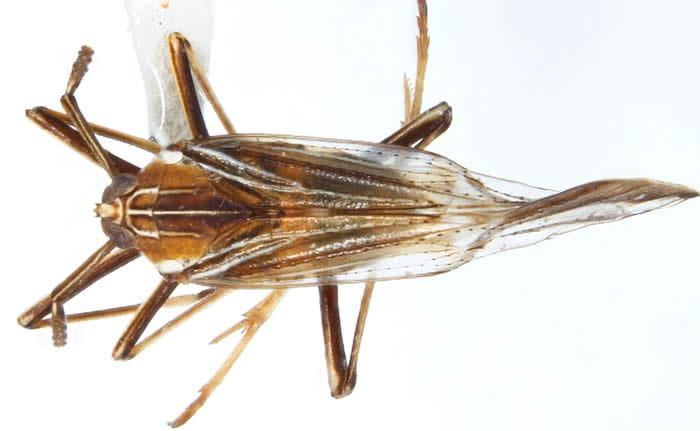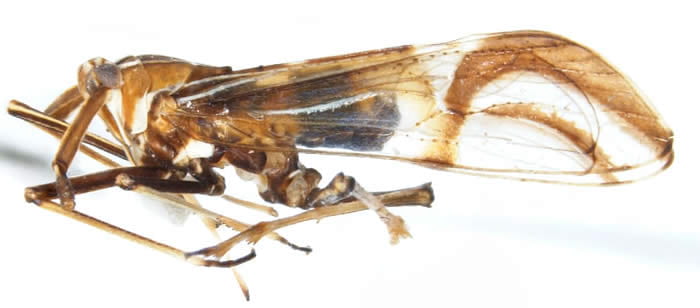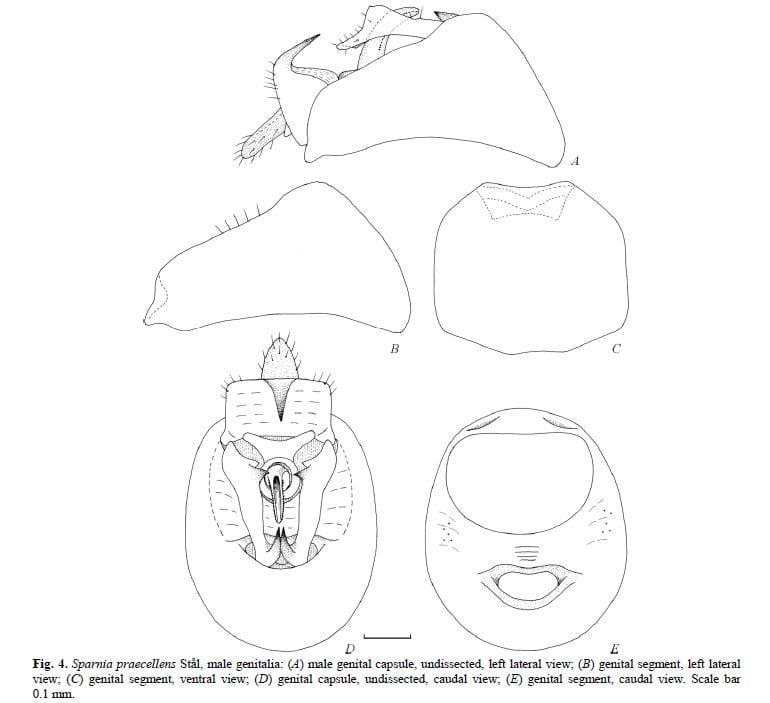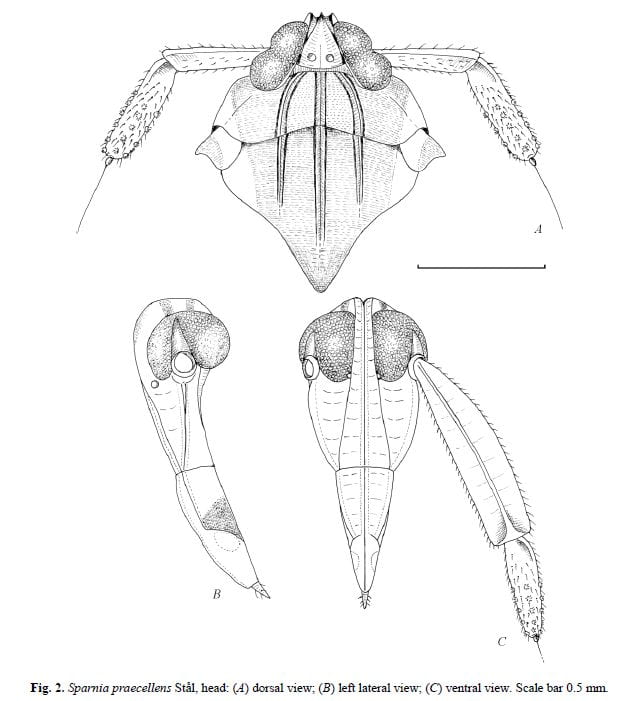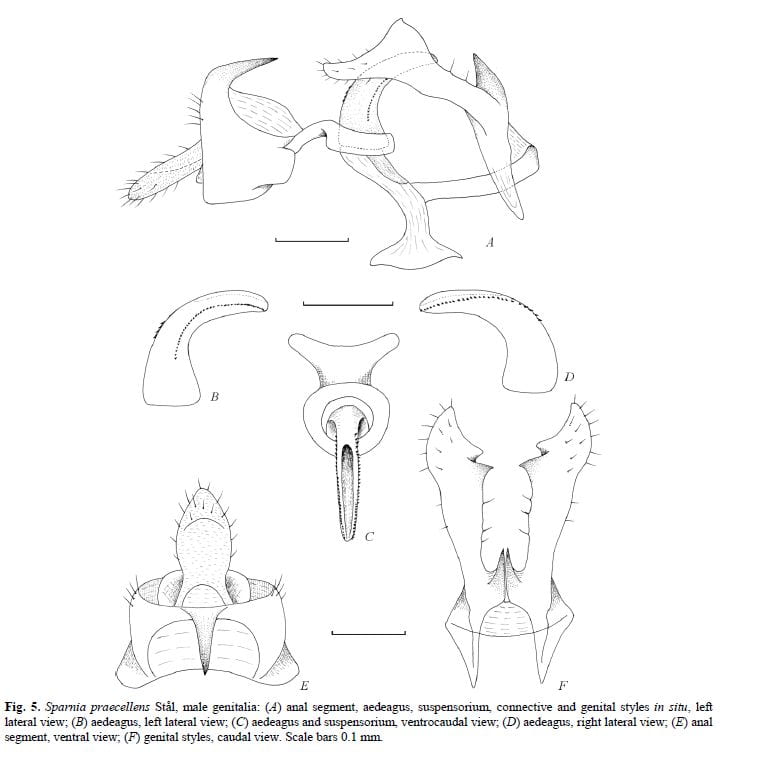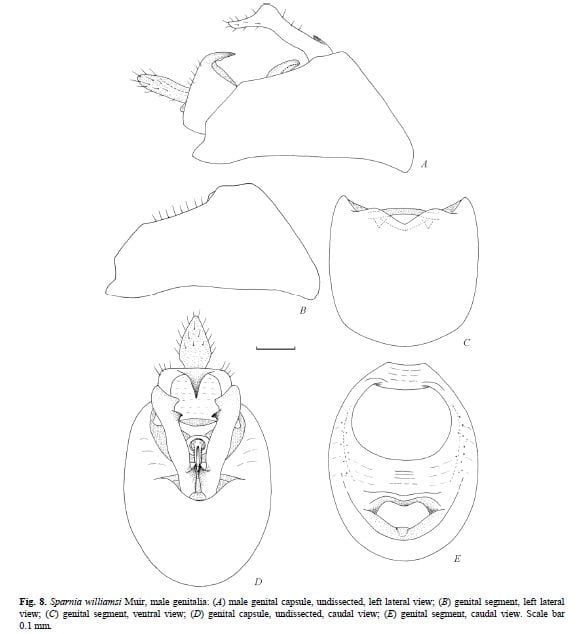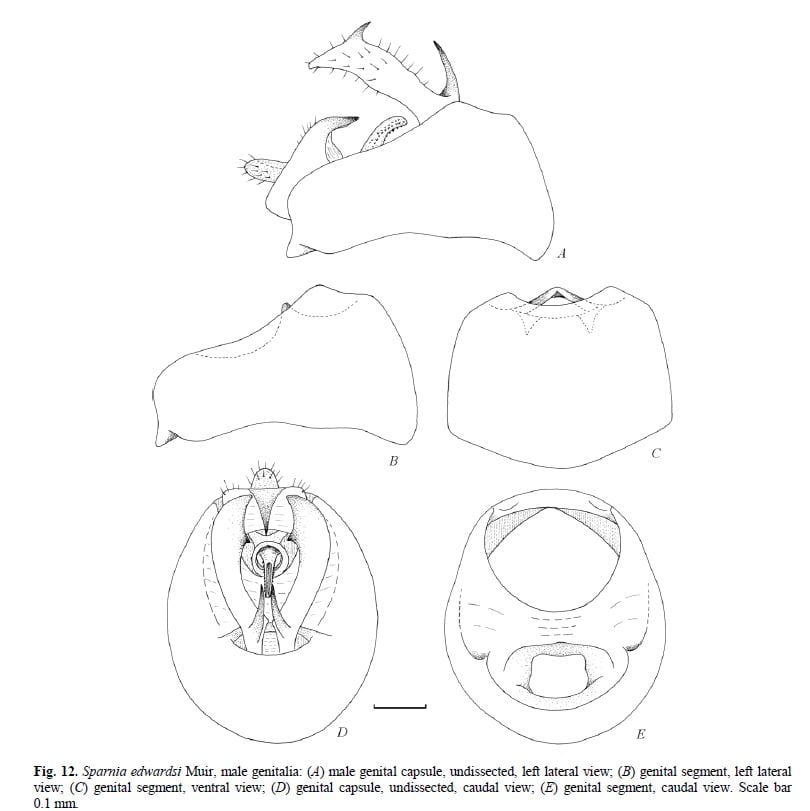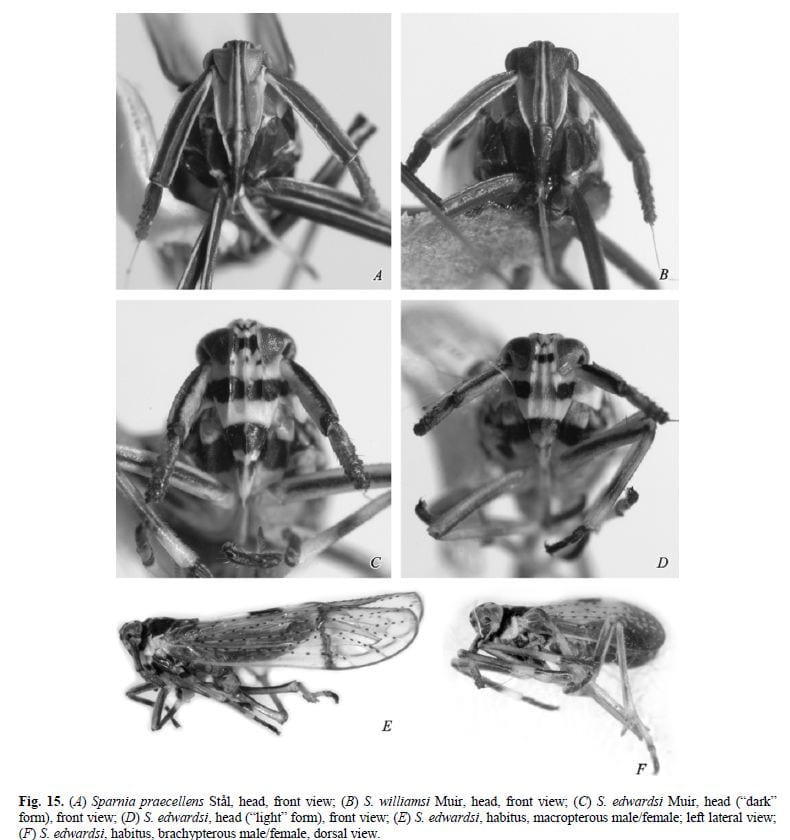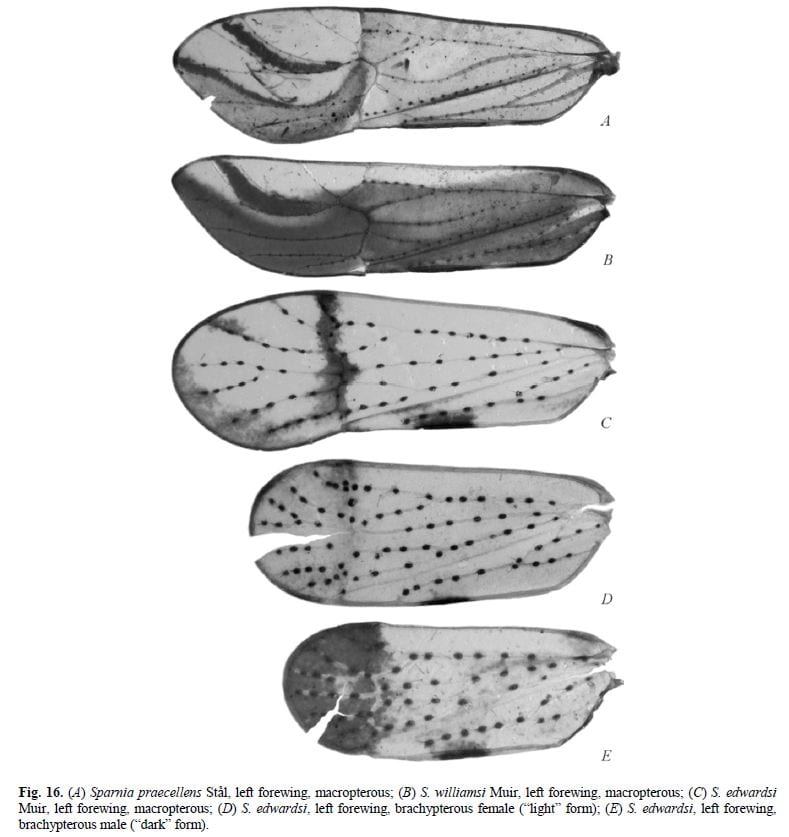[Back to Higher classification of Delphacidae]
Contents
Family Delphacidae Leach, 1815
Subfamily Delphacinae Leach, 1815
Tribe Delphacini Leach, 1815
Genus Sparnia Stål, 1862: 6.
Type species: Sparnia praecellens Stål, 1862: 6 (by monotypy).
Distribution
Tropical South America (Endemic to South America from Venezuela in the North to Chile in the South.).
Recognized species
This genus is represented by three species
Sparnia: Stål, 1866 : 175 [Key]; Ashmead, 1889 : 25 [Key]; Muir, 1915 : 296 [Key]; Muir and Giffard, 1924 : 4 [Key]; Muir, 1926 : 6 [listed]; Metcalf, 1943 : 108 [listed]; Fennah, 1959 : 250 (Key), 252 [listed].
Sparnia edwardsi Muir, 1927 – Chile (Chiloe Is.; type locality), mainland opposite of Chiloe Island.
Sparnia praecellens Stål, 1862: 6 – Brazil (Rio de Janeiro, type locality), Ecuador, Peru, Venezuela, Colombia.
Sparnia williamsi Muir, 1926 – Ecuador (type locality: Naranjapata).
Economic importance
Sparnia praecellens was reported by Muir (1926) from sugarcane in two locations (Bucay ~1,000 ft elevation; Banos ~6,000 ft elevation), and was listed by Box (1953) as a sugarcane insect.
Plant associations
Sparnia praecellens – reported from sugarcane (Saccharum officinarum L) (Poaceae); Muir & Giffard (1924: 7), Asche & Emeljanov (2016).
See FLOW. No hosts listed in Wilson et al. 1994.
Recognition
This genus is very distinctive; one of few Delphacini with flattened antennae, but differs from other Delphacini with flattened antennae in having both segments quite long, reaching or exceeding the mesonotum.
Specimens are uncommon in collections but sometimes found in series (Sparnia praecellens, at least). Probably locally common.
Tere are a couple of images on iNaturalist (williamsi – not the nymphs; and praecellens)
This genus was recently revised by Asche and Emeljanov 2016 (to my surprise, they reported no new species); genus diagnoses, commentary, and key (below) modified from that text
Asche & Emeljanov 2016: 1210-1211
“Stål (1862 : 6) described the genus in Latin and characterized only the external characters of the head including antennae as well as the thorax including tegmina and legs. He mentioned a short and narrow vertex (coryphe) (“caput vertice parvo, antrorsum angustato, latitudine vix longiore”), a narrow and elongate frons (metope) with foliately ridged lateral carinae (“fronte … angusta, elongata, … marginibus lateralibus carinato-elevatis”); furthermore, elongate, parallel-sided and compressed antennae (“Antennae longae, …, compressae, parallelae, …”), and a tricarinate mesonotum with carinae parallel to each other (“Thorax cum scutello parallele tricarinatus”). He described the tegmina as fully developed and distinctly surpassing the apex of the abdomen (“Tegmina completa, abdomen multo superantia, …”); he clearly referred to the shape of the claval vein (Pcu+A1, “Y-vein”) (“corio venis tribus longitudinalibus, furcates, pone medium convergentibus, …”) and to the apical cells of which the median one is the longest and widest (“areolis apicalibus longis, media longiore, latiore.”). Finally he characterized the legs as elongate, slender and simple (“Pedes longiusculi, graciles, spimplices.”). Stål (1862) stated an affinity of Sparnia to the genus Araeopus Spinola, 1839 (“Genus Araeope affine.”).
Diagnosis. The genus Sparnia Stål can readily be distinguished from other South American delphacid genera by the following combination of characters: head distinctly narrower than pronotum, vertex (eucoryphe with areolet) subtriangular, compartmentation absent or faint; frons (eumetope) very elongate and narrow, at least apically deeply concave, frontal carinae elevated; antennae extremely elongate, partly surpassing anteclypeus, scape foliately compressed, in two species with a distinct longitudinal median rib; legs slender, elongate; post-tibial spur slender, terete in cross-section, posterior margin with separated coneshaped teeth (“alohinoid”). Male genitalia with rather elongate genital styli which are basoventrally furnished with a spinose process and apically with two projections pointing medially; with a short anal segment which ventrocaudally displays a single spinose process; with a rather short tubular aedeagus which is bent ventrally and furnished on both sides with minute teeth; with a suspensorium which consists of a sclerotized ring surrounding the aedeagal base and a dorsal flange.”
…
Key to the Species of Sparnia Stål (slightly modified – mostly formatting – from Asche and Emeljanov 2016)
- Metope (frons) and genae with a broad, mostly blackish transverse stripe; coryphe (vertex) with a faint but distinct apical compartment; tegmina of macropterous form apically broadly rounded, largely translucent, brownish at nodal line only; in hind wing M and CuA separated from each other; antennae with scape about 1.5 times as long as pedicel ………………………………….. S. edwardsi Muir.
1’- Metope (frons) and genae devoid of blackish transverse stripe; coryphe (vertex) devoid of apical compartment; tegmina of macropterous form apically pointed, in most parts with brown color patterns; in hind wings M and CuA posteriorly forming an anastomosis; antennae with scape about twice as long as pedicel … 2.
- Tegmina very narrow, not widening beyond nodal line, nearly entirely brown; antennae with scape rather narrow: in front view about 5.8 times as long as wide, lamina maxillaris entirely pale yellow … S. williamsi Muir.
2’- Tegmina not so narrow, widening beyond nodal line, with semicircular color pattern on membrane; antennae with scape broader: in front view about 4.8 times as long as wide; lamina maxillaris ventrally dark brown ………………….. S. praecellens Stål.
Sparnia williamsi
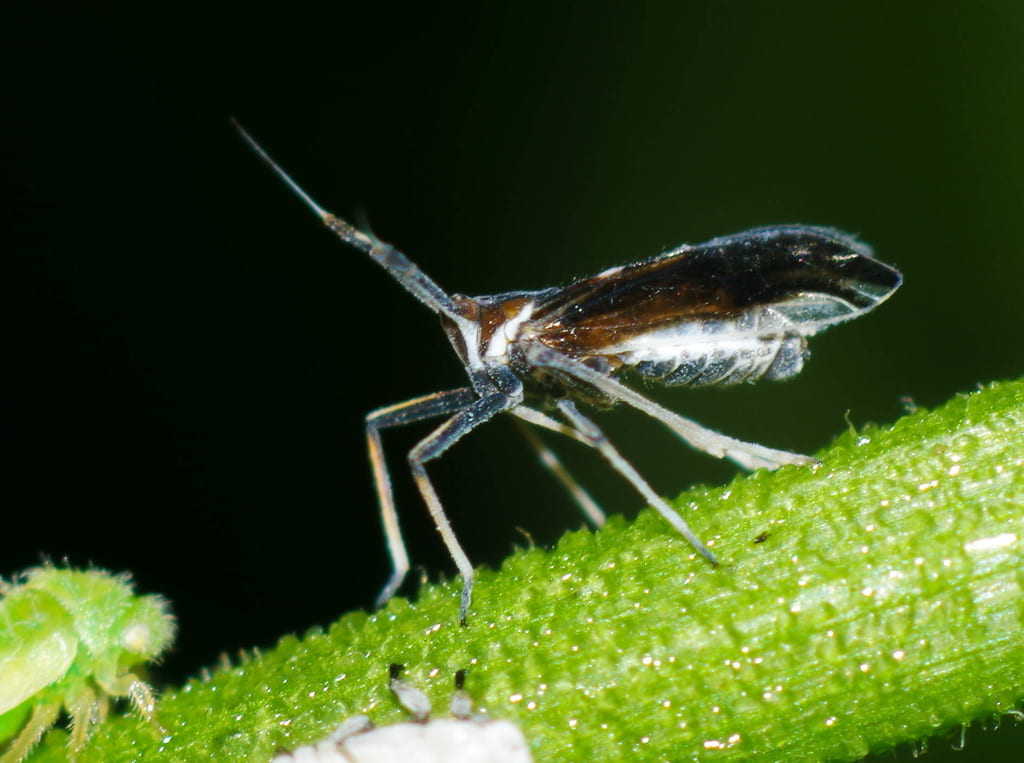
Sparnia williamsi with treehopper nymphs (Pedro Vicente Maldonado, Ecuador by David Marcelo Torres Arízaga on iNaturalist, used by permission – Thank you)
Sparnia praecellens
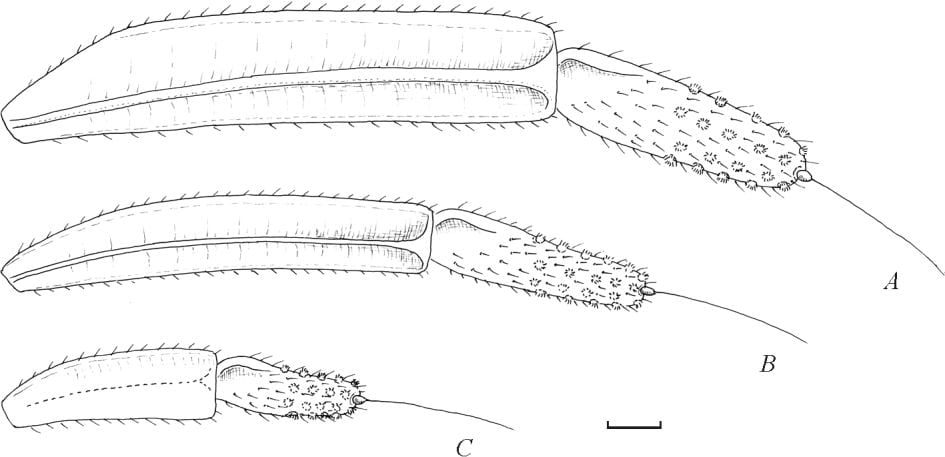
Sparnia antennae from Asche & Emeljanov 2016 (Figure 1, left antenna, front view: (A) S. praecellens Stål; (B) S. williamsi Muir; (C) S. edwardsi Muir. Scale bar 0.1 mm.)
Figures from Asche and Emeljanov (2016)
Online resources
3i.
EOL.
Discover Life.
FLOW.
Kunzweb Gallery. (link to family)
American Insects.
BOLD. (link to subfamily, genus not present)
GBIF.
iNaturalist.
Molecular resources
None (as of 19 Sept. 2017).
Selected References
Asche, M. and A. F. Emeljanov. 2016. Review of the Neotropical genus Sparnia Stål (Hemiptera, Fulgoroidea: Delphacidae). Entomologicheskoe Obozrenie 95(4): 860–888 [In Russian; English Translation Entomological Review 96(9): 1209–1233].
Ashmead, W. H. 1889b. A generic synopsis of the Fulgoridae (concluded). Entomologica Americana 5: 21-28. [Key to the genera of Fulgoridae, Sparnia P. 25.]
Box, H. E. 1953. List of sugar-can insects. Commonwealth Institute of Entomology, London.
Fennah, R. G. 1959. Delphacidae from the Lesser Antilles (Homoptera: Fulgoroidea). Bulletin of the British Museum (Natural History) Entomology 8: 245-265. (Sparnia on p. 252)
Leach, W. E. 1815a. Entomology. The Edinburg encyclopedia; conducted by David Brewster 9: 57-172. (family Delphacidae here).
Llano, C. A., C. R. Bartlett and G. Guevara. 2016. First record of the subfamily Asiracinae and Copicerus irroratus (Hemiptera: Auchenorrhyncha: Delphacidae) in Colombia. Florida Entomologist 99(1): 120-122. [Colombia record of Sparnia reported]
Metcalf, Z. P. 1943. General Catalogue of the Hemiptera. Fascicle IV, Fulgoroidea, Part 3, Araeopidae (Delphacidae). Smith College, Northhampton, Massachusetts. 552 pp. (Sparniaon P. 108).
Muir, F.A.G. 1915b-e. A contribution towards the taxonomy of the Delphacidae. Canadian Entomologist 47: 208-212, 261-270, 296-302, 317-320. (Sparnia p. 317; also Pp. 212; 267, 296 [key]; 319.
Muir, F.A.G. 1926b. Contributions to our knowledge of South American Fulgoroidea (Homoptera). Part I. The Family Delphacidae. Experiment Station of the Hawaiian Sugar Planters’ Association, Entomological Series, Bulletin 18:1-51, plates 1-5.
Muir, F.A.G. 1927d. A new species of Sparnia, Stål, from South Chile (Delphacidae: Homoptera). Annals and Magazine of Natural History, series 9 20: 296.
Muir, F.A.G. and W. M. Giffard. 1924. Studies in North American Delphacidae. Bulletin of the Experiment Station of the Hawaiian Sugar Planters’ Association, Entomological series no. 15: 1-53.
Stål, C. 1862e. Bidrag till Rio Janeiro-traktens Hemipterfauna II. Kongliga Svenska Vetenskaps-Akademiens Handlingar 3(6): 1-75.
Stål, C. 1866a. Hemiptera Homoptera Latr. Hemiptera Africana vol. 3-4. Officina Norstedtiana, Stockholm, Sweden. 200 + 276 pp.
Wilson, S. W., C. Mitter, R. F. Denno and M. R. Wilson. 1994. Evolutionary patterns of host plant use by delphacid planthoppers and their relatives. Pp. 7-45 & Appendix. In: R.F. Denno and T.J. Perfect, (eds.). Planthoppers: Their Ecology and Management. Chapman and Hall, New York.


